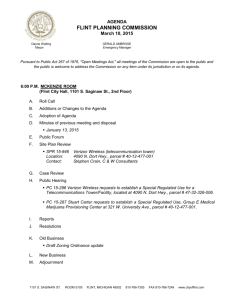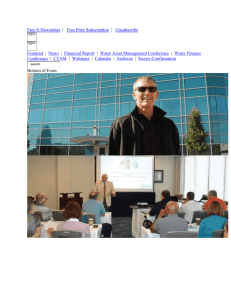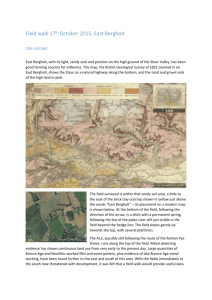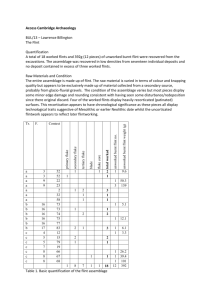VII Raw Material Usage in the Paleolithic
advertisement
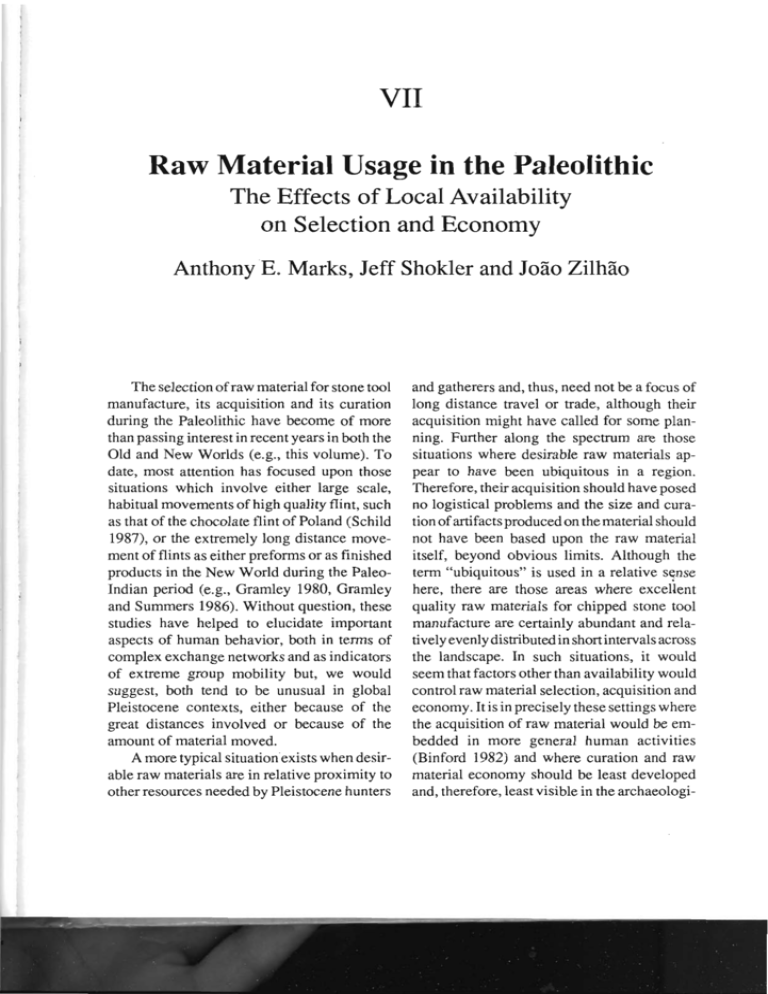
VII Raw Material Usage in the Paleolithic The Effects of Local Availability on Selection and Economy Anthony E. Marks, Jeff Shokler and Jolo Zilhlo The selection of raw material for stone tool manufacture, its acquisition and its curation during the Paleolithic have become of more than passing interest in recent years in both the Old and New Worlds (e.g., this volume). To date, most attention has focused upon those situations which involve either large scale, habitual movements of high quality flint, such as that of the chocolate flint of Poland (Schild 1987), or the extremely long distance movement of flints as either preforms or as finished products in the New World during the PaleoIndian period (e.g., Gramley 1980, Gramley and Summers 1986). Without question, these studies have helped to elucidate important aspects of human behavior, both in terms of complex exchange networks and as indicators of extreme group mobility but, we would suggest, both tend to be unusual in global Pleistocene contexts, either because of the great distances involved or because of the amount of material moved. A more typical situation-existswhen desirable raw materials are in relative proximity to other resources needed by Pleistocene hunters and gatherers and, thus, need not be a focus of long distance travel or trade, although their acquisition might have called for some planning. Further along the spectrum are those situations where desirable raw materials appear to have been ubiquitous in a region. Therefore, their acquisition should have posed no logistical problems and the size and curation of artifactsproduced on the material should not have been based upon the raw material itself, beyond obvious limits. Although the term "ubiquitous" is used in a relative sense here, there are those areas where excelient quality raw materials for chipped stone tool manufacture are certainly abundant and relatively evenly distributed in short intervals across the landscape. In such situations, it would seem that factors other than availability would control raw material selection, acquisition and economy. It is in precisely these settings where the acquisition of raw material would be embedded in more general human activities (Binford 1982) and where curation and raw material economy should be least developed and, therefore, least visible in the archaeologi- 128 PUBLICATIONS IN ANTHROPOLOGY 19 Marks, Shokler and Zilhiio cal record. In order to see whether relatively abundant and locally available raw material inhibits raw material economy or determines raw material selection, this paper will examine two different Pleistocene contexts. In each case, the examination must be considered preliminary from this point of view and certainly open to modification. A brief and far from complete review of the literature for both the New and Old Worlds suggests that when raw material sources are less than ca. 20-30 km from a site, they are considered local and little consideration is given to them compared to those sources which are further away (e.g., Tankersley 1990). It seems intuitively clear that distance from raw material, per se, would be only one factor which would affect its selection, exploitation and curation, although it should be a powerful one if distances are great. On the other hand, as proximity to desired raw material increases, the actual distance between it and a site should have less and less impact. Perhaps because of this seemingly obvious proposition, attention has been given over mainly to raw materials, the sources of which are located at considerable distances from the sites in which they are found (Geneste 1989). The two examples examined here come from quite different geographic and temporal settings, as well as having quite distinct raw material resources. In addition, one example will consider variability within a single technological and settlement system, while the other example will examine raw material se4 lection across three different industrial complexes found in the same immediate area over time. In the central Negev, Israel, just south of Sde Boker (Fig. 7.1), there is a conjunction of both abundant flint and perennial springs. The flint is high grade Eocene and Sinomainian and is available as moderate to large cobbles, up to 50 cm in length, at distances of no greater than 3 km apart. These sources are and were available at the surface as both conglomerates and as in situ nodules in the limestone cliff faces. From the point of view of the prehistoric flint knapper, all these sources contained materials of essentially the same quality, and little other flakable stone was present in the area. Compared to most other areas in the Negev, flint could be considered ubiquitous. The zone, referred to as the Advat-Aqev area, is characterized by three distinct topographic levels, each close to 100 m higher or lower than the ones adjacent to it and separated from them by either true cliffs or very steep slopes. While flint isvery abundant, it is mainly limited to the 500 m elevation, with small amounts at the other elevations. The other main resource, predictable surface water, is mainly located at the 400+ m elevation, although one major spring was at 500 m (Fig. 7.2). A third important resource for Middle Paleolithic hunters and gatherers would have been megafauna which would have been most abundant on the plains at 500 m. Although a number of resources were available at the 500 m elevation, they were not spatially congruent; the flint sources tended t6 be at some distance from the perennial springs, while both the springs and flint were only at the far edges of the then grass-covered plain (Fig, 7.2). Raw Material Usage in the Paleolithic Some 55 km2 of this area was systematically surveyed and all sites were sampled by excavation when in situ materials were present and through systematic surface collections when the material was strictly on the surface. While sites of all ages were found (Marks 1976,1977,1983), a particularly sizable sample of Middle Paleolithic sites were located (Marks 1981), two of which were large and in situ (Crew 1976, Munday 1977). Technological studies (Munday 1976) showed that all sites belonged within the same industry-the Early Levantine Mousterian-and from Th/U dates 129 (Schwarcz et al. 1979) and geomorphic studies (Goldberg 1976,1983), all these sites could be dated to between soinewhat more than 80,000 B.P. and ca. 70,000 B. P. If we accept this duration as representing contemporaneity, at least as having a single settlement system, then it is possible to define a complex, radiating settlement pattern (Marks and Freidel 1977), consisting of three main site types with associated locations: workshops and hunting stations immediately adjacent to raw material sourFes, base camps adjacent to large perennial springs and, finally, hunting stations situated on the Figure 7.1-ap of the Avdat area in the Central Negev, Israel. Ein Avdat, Ein Aqev and Ein Mor are perennial springs. Marks, Shokler and Zilhiio flat plain where herbivores were most likely to have grazed. As noted above, in spite of being in arelatively smallarea, no twoof the primary resources are normally located in the same place, meaning that a decision to camp one I - place, while maximizing proximity to one resources, also usually would maximize distance from another. In fact, only in a single case was a site located on a flint source also located on the plain. Since the plain, by its very I Profile AA' Figure 7.2-Advat area, showing main Middle Paleolithic sites. Open circles are perennial springs. Raw Material Usage in the Paleolithic nature, is quite large and approaches the other resources, only the effects of distance from water and raw material will be considered here (Table 7.1). The largest sites with the highestdensity of artifacts (Dl5 and D35) were situated in terraces adjacent to perennial springs. Sites adjacent to raw material sources (D40, D42, D44, D46) were considerably smaller, sat on bedrock or were deflated from thin loessic deposits and lacked great artifactual densities, while the single site on the plain away from both water and flint was too heavily deflated to be sure of its original size or artifact density (Table 7.1). While the high density of artifacts in the terrace sites is partly a function of an alternation between terrace aggradation and deflation, equal occupation of the thin loessic surfaces would have produced comparable artifact densities; only the depth of cultural deposits at the terrace sites would be greater. Thus, the high densities in the terrace sites do indicate more intensive and extensive flaking took place at those sites than at the other sites. Considering that the greatest round-trip distance from a spring-side terrace site and the 131 nearest source of high quality raw material was only 1.2 km, it might be expected that no significant difference in raw material economy would be seen between terrace sites and those at the source of the flint. In fact, there are some major differences (Table 7.2). Certainly, some of these differences relate to different site functions (workshops versus camp sites versus hunting stations-seeMarks 1989),but, mainly it is distance from raw material, per se, which seems to be the major factor accounting for certain specific variability. Thus, while site D52, from its location far from water and flint but i n the middle of the plain, may be interpreted as a hunting station (Table 7.1), it has more in common with camp sites away from raw material and near water than it does with hunting stations (e.g., D40) close to raw material (Table 7.2). Site D46, another hunting station, which is only moderately far from water but sits on raw material is comparable in many ways with sites D42 and D44, which are clearly workshops, while the hunting station D40 also is like those workshops. Those elements seemingly controlled by distance to raw material are overall size of Table 7.1. Attributes of central Negev Middle Paleolithic sites in the Avdat-Aqev Area (after Munday 1976,1977,1979). To raw mat 111 To water ( I 1 Size m2 "?'signifies that the site was too deflated to judge these attributes. (1) first number is horizontal distance, second is elevation in meters. Artifact density Percent cores " Marks, Shokler and Zilhio artifacts, core volume and blank thickness (Table 7.2), while site function controls such elements as core to blank ratios, artifact density, percent of cores (Table 7.1) and Levallois blank and Levallois point to Levallois flake and point core rations (Munday 1976, Marks 1989). Based on these data, it seems clear that even relatively minor differential distances from raw material can have, and in this case did ' have, a significant impact of raw material economy. The people occupying these sites chose to accept smaller and lighter blanks on average and to reduce cores further at sites near perennial springs than they did at sites located on raw material sources. This suggests that habitation proximity to surface water was a higher priority than was proximity to the raw material. It also indicates thatraw material was often acquired as a separate and purposeful activity, rather than being embedded in other activities (Marks 1988b). Table 7.2. Assemblage attributes of Middle Paleolithic sites in the Avdat-Aqev area (modified from Munday 1976). Debitane mean I. (nun) Dl5 D35.1 D35,c D52 D44 D42 D40 D46 49.1 49.1 52.4 45.4 54.1 57.8 70.3 68.1 Debitane mean th. (mm) 8.9 8.5 8.2 9.6 11.3 13.7 12.4 12.5 Mean core weight 46.9 77.6 49.8 43.7 159.5 124.7 190.0 156.0 Lev. b& Lev. core 16:l 11: 1 96:O 4:1 1.3:l 1:1.2 2:1 3:l Lev. pt.1 Lev.pt .c 17.5:l 7:1 46:O 1:l 1 :5 1:2.5 1.6:1 2.3:l Sites D15; D35.1; D35.c are interpreted as base camps; D42 and D44 are workshops; D52, D46 and D40 are hunting stations. The upper Rio Maior Valley in central-. Survey has been carried out over the past Portugal is immediately adjacent to the most two years for both archaeological sites and raw famous source of flint in the country, that material outcrops and all outcrops have been around the town of Azinheira (Fig. 7.3), and it sampled randomly for types and proportions of YORTUGUESE LSTREMADURA: I H E KIO MAIOR VALLEY The upper Rio Maior Valley in central-. Portugal is immediately adjacent to the most famous source of flint in the country, that around the town of Azinheira (Fig. 7.3), and it is often stated that flint in the whole upper Rio Maior vicinity is ubiquitous. In addition to the famous red Rio Maior flint, there is, at least, one outcrop of a greenish flint to the west of the valley, and there are and were abundant outcrops of quartz and quartzite cobbles, both materials being of reasonable but inferior flaking quality, in comparison to the available Survey has been carried out over the past two years for both archaeological sites and raw material outcrops and all outcrops have been sampled randomly for types and proportions of raw materials present. This survey has shown that the distributions of different raw materials are hardly uniform. The red Rio Maior flint is located along the eastern edge of the valley and farther to the east, while the lesser quality green to greenish-brown flint can be found in a band running roughly north-south formed the area of Vale Comprido, some 4 km west of the a:..*- -.-ii--.m:- 7 9 1 n-I-.:A- L. Raw Material Usage in the Paleolithic some of the flint nodules on the edge of the valley itself. These nodules, found at sampling sites 3,11,12 and 16 (Fig. 7.3), were generally greater than 8 cm in length but ranged up to as much as 20 cm in diameter. This contrasts sharply with the flint nodules from the western valley periphery, such as those found at sample sites 13 and 14,which fell between 3 cm and 8 cm in diameter. Yet, archaeological sites are abundant in all areas and, generally, are not spatially tied to these outcrops. Within the valley, there are numerous outcrops of quartz and quartzite gravels, as well as large numbers of Upper Paleolithic sites. While not immediately available at any site except Vale Comprido 5 west of the Valley (Fig. 7.3), no site is farther than 4 km from one of the flint sources, a trivial distance for hunters and gatherers. 133 The archaeology in around the Upper Rio Maior Valley is rich in Upper Paleolithic sites, including ones belonging to the Aurignacian, Gravettian, and Magdalenian complexes. Unlike the situation in the Negev where we were dealing with a single settlement system, in this case there may well have been quite different settlement systems pertaining during each period, as well as different ways of dealing with lithic procurement. The constraints in this context are site and raw material source locations, since there is, as yet, no indication of functional differentiation among the sites of any one complex or even between complexes. In most cases, the sites are in immediate proximity to abundant sources of quartz and quartzites (see Table 7.3 and Fig. 7.3 for location and proportions of raw materials available at each outcrop): such sites include Terra do UPPER R 1 0 MAIOR DRAINAGE Figure 7 . W p p e r Rio Maior drainage. Marks, Shokler and Zilhiio Manuel, Gato Preto, Vale Comprido 5, and C a b e ~ odo Porto Marinho I and 111. Two sites, Cabego do Porto Marinho I and I11 are only a score of meters apart and both are stratified in fossil sand dunes. CPM I has two radiocarbon dated components, one Early Magdalenian (ca. 16,000 B.P.) and the other Late Magdalenian (ca. 11,000 B. P.). CPM 111 has three stratified components, the lower two of which appear to be Gravettian, sensu lato, and both have been dated to ca. 23,000 B.P., while the third and upper component is Magdalenian and has been dated to ca. 11,000 B.P. The other sites are all single component occupations, either Aurignacian (Gato Preto), Gravettian (Vale Comprido 5 and Terra do Manuel), or Magdalenian (Carneira 11). Since the majority of occupations are located about half way between the two sources of flint, they had roughly equal access to the flint sources. A few sites, Vale Comprido 5, Gato Preto and Carneira 11, however, were located close to either the eastern of western flint sources (Fig. 7.3), with only Vale Comprido 5 actually sitting on an outcrop of flint cobbles. It must be emphasized, however, that no site was more than 4 km from one or the other flint source. Again, given the small distances involved, as well as the flaking superiority of the flint over the quartz and quartzites, it might have been expected that flint would be consistently procured during other activities. Thus, if the procurement of raw material was embedded in the other activities of these prouos. given the as well as the flaking superiority of the flint over the quartz and quartzites, it might have been expected that flint would be consistently procured during other activities. Thus, if the procurement of raw material was embedded in the other activities of these groups, given the two nearby flint sources, flanking most of the upper valley, then flint should have been selected for almost without exception in every period. Yet, this does not appear to have been the case. Cores were used as a measure of actual proportional procurement, as opposed to in- tensity of exploitation, since differential reduction has no effect on the number of cores, while it obviously does on the number of blanks produced from them. The single Aurignacian site, Gato Preto, is within one km of the ridge containing abundant Rio Maior flint cobbles (site samples 11 and 12, Table 7.3). In spite of this, flint represents only 35% of the cores, with quartz being dominant (Table 7.4). Although raw material studies of the finished tools have not been finished, there appears to be no parallel usage of quartz in tool production. In fact, the impression is that the vast majority of retouched tools, mainly carinated and thick nosed scrapers, are made on the red Rio Maior flint. There are four Gravettian occupations, two of them, Terra do Manuel and Vale Comprido 5, located outside the valley to the west. The former site is about 2 km from the western flint source, while the latter sits on it (Fig. 7.3). The other two are at CPM 111, stratified below a Magdalenian occupation, and no more than 4 km from the Rio Maior flint outcrop on the east side of the valley. At CPM 111, flint was selected for cores only 55% and 68% of the time, with quartz representing almost all the rest. At Terra do Manuel, the percentage of flint cores is slightly lower, 54%. On the other hand, at Vale Comprido 5, the percentage of flint cores is almost 90% (Table7. 4). In virtually all cases, it appears that quartz retouched tools are rare and, when present, tend to be simple retouched pieces or atypical scraper. Thus, a ~ a i nwe . are faced with a seeming.tendencv to Vale Comprido 5, the percentage of flint cores is almost 90% (Table7. 4). In virtually all cases, it appears that quartz retouched tools are rare and, when present, tend to be simple retouched pieces or atypical scraper. Thus, again, we are faced with a seeming tendency to select significant amounts of quartz for reduction, but not apparently to produce blanks for formal tool production, although good quality flint is locally, if not immediately, available. The Magdalenian sites areeither very close to the eastern flint source (Carneira 11) or are located in the same place as two of the Gravet- Raw Material Usage in the Paleolithic 135 Table 7.3. Percentages of different types of raw materials at sampled raw material loci. Quartz 39 21 26 42 52 46 31 48 72 23 31 22 74 24 39 27 42 21 38 35 30 Quartzite 54 63 54 57 47 45 54 47 24 61 53 54 21 79 34 64 52 Sandstone Connlomerate Limestone Other Flint S a m l e Size 5 2 4 1 3 3 4 2 4 2 1 1 55 34 5 1 4 16 2 14 61 9 61 Concretion tian sites, at CPM, some 4 km from the eastern, Rio Maior flint source. In two cases, flint was overwhelmingly selected for reduction (between 87% and 89%)-CPM I, upper and CPM 111, upper-while at CPM I, lower, the percentage of flint among the cores is only 59% (Table 7.4). Although patterns are not fully consistent, they are clear. There is a shift in raw material pref6rence through time, across the three industrial complexes. The Aurignacian shows the least tendency to procure flint, although Gato Preto as very close to the Rio Maior flint source. During the Gravettian, the popularity of flint for reduction increases but quartz remains an important element. Vale Comprido 5 seems to skew the pattern; it is likely that immediate and abundant flint availability overwhelmed the tendency to utilize quartz and quartzites (samples 13, 14 and 18-Table 7.3). The Magdalenian sites show a somewhat inconsistent pattern, with three occupations, Carneira 11, CPM I, upper, and CPM 111,upper, all heavily procuring flint almost to the exclusion of other materials. On the other hand, CPM, lower, is the only early Magdalenian occupation so far known, while CPM I, upper, and CPM 111,upper are both Late Magdalenian, dating some 5,000 later. In spite of this inconsistency, there is a clear overall pattern from early to late, with CPM I, lower, fitting well between the Gravettian and the Late Magdalenian (Fig. 7.4). How can this shift in raw material procurement be explained? Through time, there is always the chance that raw materials become more or less readily accessible because of changes in vegetation density, slope wash, deflation, alluviation, etc. In this situation, however, these factors do not seem to have Marks, Shokler and Zilhiio Table 7.4. Core percentage by raw materials and occupations. Raw Material Occupation quartz quartzite Late Magdalenian Carneira Il CPM III, upper CPM I, upper other sample size - Early Magdalenian CPM I , lower Gravettian CPM 111, middle CPM III, lower Terra do Manuel Vale Comprido 5 Aurignacian G a b Preto been significant. Both sources of flint are located along the crests of the highest ridges paralleling the valley and, therefore, were always exposed. The presence of Vale Comprido 5 on the western flint source certainly documents that it was exposed during the Gravettian, while the high percentage of scrapers on Rio Maior flint at the even earlier site of Gato Preto shows that theeastern source was exposed from the earliest known Upper Paleolithic occupation of the valley. Quartz and quartzite are literally ubiquitous, fully mixed in the flint gravels at Vale Comprido, and present in every exposure within the valley itself, including in the exposures of flint cobbles (Table 7.3). Accessibility does not seem to be a parsimonious explanation. Rather, it would seem that there were some basic cultural preferences which overshadowed resource proximity. It might have been expected that in the Negev example the abundance of fine quality raw material and the small distances between sources would have negated any tendency for differential raw material economy within a single technological system. Quite the contrary; even small distances between sites and flint sources resulted in significant economiz- ing behavior when compared with those sites located at sources of raw material. The obvious locational priority given to permanent surface water over proximity to flint sources and/or prime hunting position, combined with a tendency toward intensive occupation, are all clearly reflected in how much raw material was reduced within the different occupational Raw Material Usage in the Paleolithic 0 - CPM I LOWER .a- CPM III UPPER OUAKli'ITE Fi;NT OTHER Core percentage raw mater~albreakdown for C a b q o do Porto Marinho 1 Upper and Lower componenls. Cabwo do Port0 Mar~nho111 Upper component, and Carneira [I. 0- TDM m- CPM ill MID. -0- CPM Ill LOW. QUARTZ Core percentage raw material breakdown for Terra do Manuel. Vale Comprido 5. and Cabeto do Porto Marlnho Ill Miadle and Lower components. QUARTZ QUARTZITE FLINT Core percentage raw material breakdown for Gato Preto. Crnm Figure 7.4-Distribution of raw material procurement by site and complex. 1 I 137 Marks, Shokler and Zilhiio poses of the settlement system. It is striking that these differences manifested themselves when distances from sites to raw material sources were less than a kilometer, although much of this distance included marked elevational changes. In the Portuguese case--admittedly still very tentative and badly in need of additional data-markedly different patterns of raw material procurement took place among different cultural groups occupying the same localities over time. It is not yet clear whether the relatively high selection of quartz for reduction at Aurignacian and Gravettian sites can be correlated with the production of specific classes of less formal tools or whether their immediate availability encouraged their expedient use. If the latter is the case, the same proximity and availability failed to entice the Late Magdalenians to do likewise. Obviously, there is still a great deal to learn about local Portuguese raw material economies through time and space. These two examples suggest that raw material preferences, procurement and economy may function significantly even when the distances between sites and raw material sources are minimal. Therefore, even in areas where raw material is ubiquitous, its predictably uneven distribution across the landscape and its spatial relationship to other resources may have a marked effect on raw material economy. In each case, this needs to be defined and, if possible, explained. The work reported in this paper was made possible by a series of National Science Foundation Grants, over many years. The Negev work relating to this paper was carried out under NSF Grants GS-246l728602X,2860x1 and 42680, as part of the larger Central Negev Project. The work undertaken in Portugal is currently being supported by NSF Grant BNS- 8803798 and is under the co-direction of Drs. Marks, Southern Methodist University and Zilhio, the University of Lisbon. The raw material sources were located, sampled, and described by Mr. Jeff Shokler under an NSF Research Experience for Undergraduates supplementary award to the grant. Project. The work undertaken in Portugal is currently being supported by NSF Grant BNS- plementary award to the grant. Raw Material Usage in the Paleolithic Binford, L. 1982 The archaeology of place. Journal of Anthropological Archaeology 1(1):5-31. Crew, H. 1976 The Mousterian site of Rosh Ein Mor. In Prehistory and the Paleoenvironments in the Central Negev, Israel, Volume 1, A. Marks, ed., pp. 75-1 12. Southern Methodist University Press, Dallas. Geneste, J-M. 1989 Economie des ressources lithiques dans le Mousterien du Sud-Ouest de la France. In L'homme de Neandertal, Volume 6. M . Otte, ed., pp. 75-98. ERAUL, Liege. Goldberg, P. 1976 Upper Pleistocene Geology of the AvdatAqev Area. In Prehistory and Paleoenvironments in the Central Negev, Israel, Volume I , pp. 25-55. Southern Methodist University Press, Dallas. 1983 The Geology of Boker Tachtit, Boker, and Their Surroundings. In Prehistory and Paleoenvironments in the Central Negev, Israel, Volume 3, pp. 39-62. Department of Anthropology, Southern Methodist University, Dallas. Gramley R. 1980 Raw Material Source Areas and "Curated" Tool Assemblages. American Antiquity 45:823-33. Gramley R. and G. Summers 1986 Nobles Pond: A Fluted Point Site in Northeastern Ohio. Midcontinental Journal of Anthropology 1 1:97- 123. Marks, A. 1976 ( 4 . ) Prehistory and Paleoenvironments in the Central Negev, Israel, Volume I . Southern Methodist University Press, Dallas. 139 ( 4 . ) Prehistory and Paleoenvironments in the Central Negev, Israel, Volume 2. Department of Anthropology, Southern Methodist University, Dallas. 1981 The Middle Paleolithic of the Negev. In Prkhistoire du Levant, J . Cauvin and P. Sanlaville, eds., pp. 287-298. CNRS Colloques 598. Editions CNRS, Paris. 1983 (ed.) Prehistory and Paleonvironments in the Central Negev, Israel, Volume 3. Department of Anthropology, Southern Methodist University, Dallas. 1988 The curation of stone tools during the Upper Pleistocene: A view from the Central Negev, Israel. In Upper Pleistocene Prehistory in Western Eurasia, H . Dibble and A. Montet-White, eds., pp. 275-285. The University Museum, Philadelphia. 1989 Early Mousterian Settlement patterns in the Central Negev, Israel: their social and economic implications. In L'homme du Neandertal, Volume 6, La Subsistance, M. Otte, ed., pp. 115-126. ERAUL, Liege. 1977 Marks, A. and D. Freidel 1977 Prehistoric adaptation and settlement patterns in the Avdat-Aqev area. In Prehistory and Paleoenvironments in the Central Negev, Israel, Volume 1, A. Marks, ed., pp. 25-60. Department of Anthropology, Southern Methodist University, Dallas Schild, R. n.d.???The Exploitation of Chocolate Flint in Poland. In The Human Uses of Flint and Chert, G. Siercking and M. Newcomer, eds., pp. 137-149. The University Press, Cambridge. Schwarcz, H. B. Blackwell, P. Goldberg and A. Marks 1979 Uranium Series Dating of the travertine from archaeological sites, Nahal Zin, Israel. Nature 277:558-60. Raw Material Economies among Prehistoric Hunter-Gatherers Edited by Anta Montet-White and Steven Holen Lawrence, Kansas 1991 The University of Kansas Publications in Anthropology are numbered consecutively and appear at irregular intervals. Support for the Series comes from the Scholarly Publication Fund of the University of Kansas. The University of Kansas Publications in Anthropology are numbered consecutively and appear at irregular intervals. Support for the Series comes from the Scholarly Publication Fund of the University of Kansas. Editor: John M. Janzen Assistant Editor: Christine M. Biller Editorial Committee: Michael Crawford, John Janzen, Anta Montet-White Printed by the University of Kansas Printing Service ISSBN Z 0-938332-17-1 ISSN 0085-2457

